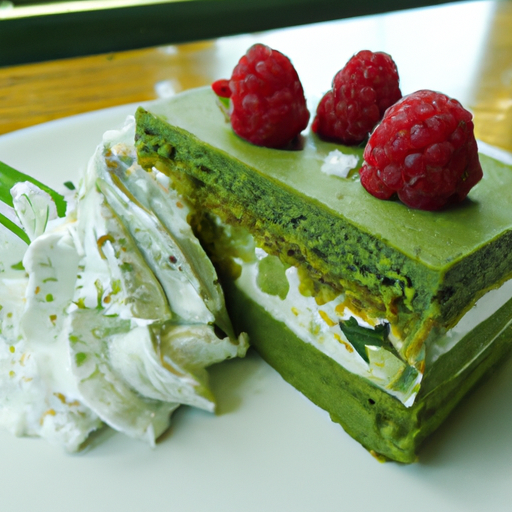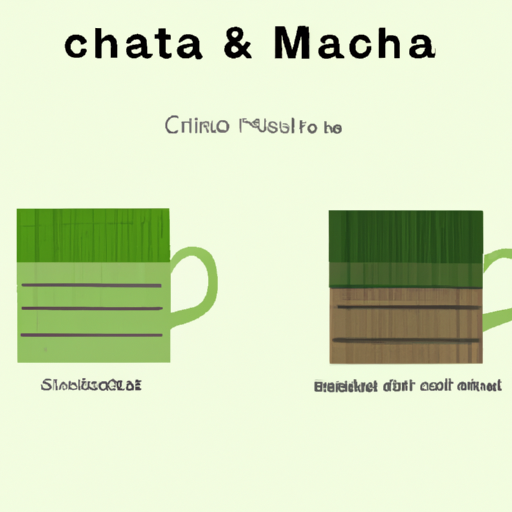Are you curious about how to create cold foam matcha? I’m here to inform you that it’s surprisingly simple—actually, it’s even simpler than rocket science! All it takes is following a few basic steps and having a few ingredients on hand, and you’ll be able to concoct your own delightful and invigorating matcha beverage topped with the ideal frothy layer.
As someone who has been on the hunt for the perfect matcha latte for years, I can confidently say that making it at home is truly the way to go. Not only is it more cost-effective than constantly buying it from cafes, but you also have complete control over the flavor and sweetness level.
Plus, impressing your friends with a homemade matcha cold foam drink is always a great feeling. So let’s get started!
Key Takeaways
- Matcha cold foam requires accurate measurements of ingredients and a metal whisk or electric frother for whisking.
- Chilled milk and a sifted matcha powder are necessary for making the foam.
- Gradually adding matcha base and sprinkling small amounts while blending prevents clumps and ensures flavor and texture.
- Matcha cold foam can be customized with flavor variations such as flavored syrups, whipped cream, and chocolate pairings.
Gather Your Ingredients
Time to get ready for some delicious matcha cold foam – let’s gather all the ingredients we need! Before starting, make sure you’ve got all the necessary ingredients and equipment ready.
For the matcha cold foam, you’ll need matcha powder, sugar, milk, and heavy cream. You’ll also need a hand mixer or a blender.
Start by preparing your ingredients. Measure out 1 tablespoon of matcha powder and 2 tablespoons of sugar into a small bowl. Mix them together until they’re well combined.
Next, measure out 1/2 cup of milk and 1/4 cup of heavy cream into a separate bowl.
Now that you have your ingredients prepared, it’s time to get your equipment ready. You can use either a hand mixer or a blender to whip up your matcha cold foam. If using a hand mixer, make sure it’s clean and dry before starting. If using a blender, make sure it’s plugged in and ready to go.
With everything prepared and ready to go, it’s time to move on to making the matcha base. Let’s get started!
Make the Matcha Base
Now that I’ve gathered all my ingredients, it’s time to make the matcha base.
To do this, I need to measure out the necessary amount of matcha powder and hot water. Once measured, I’ll whisk them together until a smooth and creamy consistency is achieved.
Measure Ingredients
To whip up the perfect matcha cold foam, ya gotta measure out the right amount of matcha powder and milk. Measuring accuracy is key to ensuring that your cold foam will turn out just right.
I recommend using a digital kitchen scale to accurately measure out 2 teaspoons of matcha powder and 1/4 cup of milk. This way, you can be sure that you’re using the exact measurements needed for a delicious and frothy matcha foam.
When it comes to choosing utensils, I highly recommend using a metal whisk or an electric frother for best results. A metal whisk will give you more control over the texture of your cold foam, while an electric frother will make whipping up the perfect foam effortless.
Just make sure to use a whisk or frother with small blades or tines so that it can effectively mix together all of your ingredients.
Now that we’ve measured out our ingredients and chosen our utensils, it’s time to move on to the next step: whisking everything together!
Whisk Together
Get ready to blend your ingredients together by grabbing your metal whisk or electric frother. Whisking is a crucial step in making matcha cold foam, as it helps create that creamy and airy texture we all love. You can use any type of whisk, but I recommend using an electric frother for best results.
When whisking the matcha powder with hot water, be sure to use a back-and-forth motion rather than circular motions to avoid clumping. Once you’ve created a smooth and vibrant green mixture, add in your chilled milk and continue to whisk until you see peaks forming on the surface. The longer you whisk, the thicker the foam consistency will become.
Now that our matcha cold foam is ready, it’s time to chill the milk before assembling our drink.
Chill the Milk
Once the milk has been refrigerated, it’s time to move on to preparing the matcha powder. Before getting started, I always make sure that my milk is cold enough by chilling it for at least 30 minutes. Chilling techniques vary depending on your preference and what type of milk you’re using. If you’re using regular dairy milk, simply placing it in the fridge will do the trick. However, if you prefer a non-dairy option like almond or soy milk, be sure to use a brand that is specifically designed for frothing.
To ensure that my matcha cold foam comes out perfectly every time, I like to follow a few simple steps when preparing my chilled milk. First and foremost, I always make sure that my container or pitcher is clean and free from any residue or leftover flavors. Next, I pour in my desired amount of milk and place it in the fridge until it reaches the desired temperature. While waiting for the milk to chill, I prepare my matcha powder by sifting it through a fine mesh strainer into a separate bowl.
Once my chilled milk is ready to go, I take out both bowls and carefully whisk together the matcha powder with a small amount of hot water until it forms a smooth paste-like consistency. Then, using either an electric frother or handheld whisk, I begin frothing up my chilled milk until soft peaks start to form. With these two components now prepared and ready to go, it’s time to move on to making the actual cold foam itself!
Make the Cold Foam
So now that the milk is chilled, it’s time to move on to making the cold foam. First, I blend the milk and sweetener together until they’re well combined and frothy.
Next, I add ice and blend again until the mixture becomes even thicker. Finally, I gradually add in the matcha base while continuing to blend until everything is fully incorporated.
Just like that, we’ve got a deliciously creamy and flavorful cold foam for our matcha latte!
Blend Milk and Sweetener
Firstly, I start by blending the creamy milk and sweetener together until a smooth mixture forms. I prefer to use oat milk as it has a natural sweetness that complements the matcha flavor well, but any milk alternative can be used depending on personal preference.
When blending, I make sure to use a high-speed blender and blend for at least 30 seconds to ensure that the mixture is completely smooth. Blending techniques are crucial when making cold foam as any lumps or unevenness in the mixture will affect the final texture of the foam.
Once blended, this velvety milk mixture is ready to be combined with our previously made matcha foam. But before that, we need to add ice and blend again for a few seconds until everything is well combined and frothy.
The result is an indulgent and refreshing drink that’s perfect for hot summer days or anytime you’re in the mood for something sweet and creamy.
Add Ice and Blend Again
After blending the milk and sweetener, I like to toss in a few ice cubes and give it another whirl in the blender. This blending technique adds a refreshing twist on the classic matcha drink, making it perfect for those hot summer days.
The ice cools down the drink while also creating a frothy texture that complements the smoothness of the milk. Once you’ve blended everything to perfection, feel free to get creative with alternative toppings such as whipped cream or chocolate syrup.
But before we move onto that step, let’s first focus on gradually adding the matcha base for that rich green color and signature earthy taste.
Gradually Add Matcha Base
Next up, it’s time to add the matcha base to your blended mixture and get that beautiful green color and delicious earthy taste. Adding matcha base is a crucial step in making matcha cold foam, and there are some tips and techniques I’ve learned over time to ensure a perfect outcome.
Firstly, it’s important to measure the amount of matcha base accurately. Too much or too little can drastically affect the flavor and texture of your cold foam. I usually use around 1-2 teaspoons of matcha powder for every cup of milk used in the recipe.
Secondly, instead of adding the entire amount at once, gradually sprinkle small amounts into the blender while it’s running on low speed until you achieve your desired level of green color and taste. This will also help prevent clumps from forming in your foam.
With these simple tips in mind, you can create a smooth and creamy matcha cold foam that’ll elevate any drink!
Now that we’ve added our perfectly measured matcha base into our blended mixture, let’s move onto pouring our delicious creation into our cup for consumption without any delay!
Pour the Matcha Drink
Now it’s time to pour the matcha drink into a tall glass filled with ice. Don’t be afraid to fill it up! You want to enjoy every sip of this delicious and refreshing drink. When pouring, make sure you use a steady hand so that you don’t spill any of the matcha.
Mixing techniques can also be used when pouring the matcha drink. To create a more evenly mixed beverage, stir the contents of your glass for a few seconds before taking your first sip. This will ensure that all of the flavors have blended together perfectly.
Serving suggestions include adding some extra ice cubes or even some fresh mint leaves on top for an added burst of flavor and aroma. Once you’re happy with your matcha drink, it’s time to add the cold foam on top!
Add the Cold Foam
Who doesn’t love a creamy, dreamy topping on their drink? That’s right, it’s time to add that luscious foam to your matcha masterpiece! Adding the cold foam is the final step in making this refreshing beverage. To achieve the perfect foam consistency, I recommend using a milk frother or an electric hand mixer.
Here are three sub-lists to help you create the ideal cold foam:
- Use 1/2 cup of heavy cream and 1 tablespoon of sugar for every serving size of matcha drink.
- Make sure that the heavy cream is chilled before whipping it into a fluffy texture.
- Whip the cream until it forms stiff peaks and has a creamy texture.
Once you have created your desired foam consistency, gently spoon it over your iced matcha drink. You can either fill up the entire glass with foam or leave some space at the top for garnishing. Remember to adjust the serving size according to your preference!
Now that you’ve added the cold foam to your matcha drink, let’s move onto garnishing it with some additional toppings for extra flavor and texture.
Garnish the Drink
Now it’s time to add the finishing touches to our Matcha Cold Foam drink. I always start by sprinkling some Matcha powder on top of the foam for an extra pop of flavor and color.
Then, I like to add a dollop of whipped cream and drizzle some syrup over the top. These simple garnishes take this drink from good to great and are sure to impress your friends or customers.
Sprinkle Matcha Powder
To achieve a perfect matcha cold foam, simply sprinkle some matcha powder over the top and watch as it transforms into a delicious treat! Matcha powder is made from finely ground green tea leaves and has a variety of uses in cooking and baking. It’s important to note that not all matcha powders are created equal – there are different grades and types available depending on their intended use.
In general, higher quality matcha powders will have a brighter green color and a smoother, less bitter taste. They are typically used for ceremonial purposes or in high-end culinary applications. Lower quality matcha powders may be more affordable but can have a duller color and more bitter taste. These are often used in commercial food products or for home cooking needs. By sprinkling the right amount of matcha powder onto your cold foam, you can elevate the flavor profile of your drink to new heights!
Now that you’ve added the finishing touch of sprinkled matcha powder, let’s move onto the next step: adding whipped cream!
Add Whipped Cream
Adding whipped cream is the cherry on top of your matcha latte, making it even more indulgent. But did you know that there are alternatives to traditional whipped cream?
If you’re looking for a dairy-free option, coconut whipped cream is a popular choice. It’s made by whipping coconut cream until it becomes light and fluffy, and can be used just like regular whipped cream. Another alternative is using aquafaba, which is the liquid from canned chickpeas that has been whipped into a foam. It may sound strange, but it actually works well as a vegan substitute for whipped cream.
Besides adding it to your matcha latte, there are other drinks where using whipped cream can take them to the next level. For example, adding a dollop of whipped cream to hot chocolate or coffee can make them feel extra special. You can also experiment with different flavors of whipped cream by adding extracts or spices such as vanilla or cinnamon. The possibilities are endless when it comes to incorporating this creamy topping into your beverages.
As we move onto the next section about adding syrup, remember that while whipped cream may not be for everyone, there are plenty of alternatives out there to try. Adding syrup will sweeten up your matcha cold foam and give it some extra flavor depth.
Add Syrup
If you’re craving a sweeter taste in your matcha latte, try incorporating a syrup of your choice. There are many syrup flavors available that can enhance the sweetness level of your matcha cold foam. Some popular options include vanilla, caramel, and hazelnut.
When adding syrup to your matcha cold foam, it’s important to start with a small amount and adjust according to your taste preferences. You don’t want to overpower the delicate flavor of the matcha with too much sweetness. Once you’ve added the syrup, give it a quick stir before topping it off with the cold foam for an even distribution of flavor.
With just a touch of sweetness from some flavored syrup, you can create a personalized version of this trendy drink that satisfies your sweet tooth without being too overwhelming.
Now that you’ve perfected your matcha cold foam recipe by adding whipped cream and flavored syrups, it’s time to enjoy! Sit back and take in all the deliciousness as each sip provides a refreshing boost of energy and antioxidants.
Enjoy Your Matcha Cold Foam
As you savor your matcha cold foam, feel the creamy texture of the foam and the bold flavor of the matcha blend together in perfect harmony.
Matcha isn’t just a delicious ingredient, but it also has numerous health benefits. It contains antioxidants that help boost metabolism and lower cholesterol levels. Additionally, matcha is an excellent source of energy, making it a great alternative to coffee.
There are different ways to use matcha powder aside from making a cold foam. You can add it to smoothies or baked goods for an extra kick of flavor and nutrition. However, nothing beats the refreshing taste of a well-made matcha cold foam on a hot summer day.
Experiment with flavor variations by adding syrups or toppings like whipped cream or chocolate shavings to create your unique twist on this classic beverage. With its vibrant green color and rich taste profile, matcha cold foam is sure to satisfy any craving for something sweet yet healthy.
Experiment with Flavor Variations
I love experimenting with different flavors when making matcha cold foam. Some of my favorites to play around with are vanilla, caramel, and chocolate. Adding a hint of vanilla extract can give the foam a subtle sweetness. Drizzling caramel syrup on top can create a deliciously indulgent treat. And for those who crave something rich and decadent, stirring in some cocoa powder or melted chocolate chips is sure to satisfy your sweet tooth.
Trust me, these flavor variations will take your matcha cold foam game to the next level!
Vanilla
You’ll love the sweet and creamy taste of vanilla in your matcha cold foam. Vanilla is one of the most popular variations to add to matcha drinks, and for good reason.
Not only does it enhance the flavor profile of your matcha drink, but it also provides a host of health benefits. Vanilla variations can range from using pure vanilla extract to vanilla syrup or even vanilla beans.
In addition to providing a delicious flavor, adding vanilla to your matcha drink can help reduce anxiety and improve digestion. It’s also a great source of antioxidants and can help regulate blood sugar levels.
So why not try adding some vanilla to your next batch of matcha cold foam? As we move on to discussing caramel as another flavor variation, keep in mind that you can always mix and match flavors to create your own unique blend.
Don’t be afraid to experiment with different combinations until you find the perfect match for your taste buds!
Caramel
Oh boy, get ready to indulge in some sweet and gooey goodness with the next flavor variation: caramel.
Matcha cold foam with caramel variations is a delicious and unique way to enjoy your matcha latte. The rich and buttery taste of caramel perfectly complements the earthy notes of matcha, creating a heavenly combination that will satisfy any sweet tooth.
To make caramel matcha cold foam, you can use homemade or store-bought caramel sauce. Simply add a tablespoon of caramel sauce to your milk before whisking it into a frothy texture for your cold foam. If you’re feeling adventurous, try experimenting with different types of caramels such as salted or dark chocolate infused ones for added flavor complexity.
To serve, pour your favorite iced matcha latte into a glass and spoon the frothy cold foam on top. For an extra treat, sprinkle some crushed cookies or drizzle additional caramel on top.
Now onto everyone’s favorite flavor: chocolate!
Chocolate
Indulge in the rich and decadent flavor of chocolate, perfectly paired with the earthy tones of matcha for a truly heavenly experience. As someone who enjoys experimenting with different flavors, I’ve found that chocolate and matcha make a surprisingly delightful pairing. Not only does it satisfy my sweet tooth, but it also provides numerous health benefits.
Here are 4 ways to enjoy chocolate pairings with matcha:
- Add cocoa powder to your matcha latte for a delicious mocha twist
- Top your matcha cold foam with shaved dark chocolate for added texture and flavor
- Mix melted dark chocolate into your matcha smoothie bowl for an indulgent breakfast option
- Pair a piece of high-quality dark chocolate with your cup of hot or iced matcha
Incorporating these chocolate pairings into your daily routine not only adds excitement to your taste buds but also provides health benefits such as improved cognitive function, lower risk of heart disease, and increased antioxidant intake.
Now that we’ve explored the delicious potential of combining these two flavors together, let’s move on to some tips and tricks for creating the perfect matcha cold foam without any hassle.
Tips and Tricks for the Perfect Matcha Cold Foam
Feeling like a barista? Take your matcha cold foam game to the next level with these tips and tricks that’ll have you impressing yourself (and others) in no time.
Matcha lattes aren’t the only way to enjoy matcha. One of the best alternatives is matcha cold foam. It’s fluffy, creamy, and has a subtle sweetness that balances well with the earthy flavor of matcha.
When making matcha cold foam, it’s important to use high-quality ingredients. Choose a good quality matcha powder that’s bright green in color and has a smooth texture. For the milk, use whole milk or oat milk as they provide a richer texture for the foam compared to other types of milk. To add more depth to your drink, experiment with different flavor combinations such as honey or vanilla syrup.
To achieve perfect matcha cold foam every time, make sure that your whisk is clean and dry before using it. Also, chill your bowl and whisk in advance as this helps create better foaming action. Start by whisking vigorously until the mixture becomes frothy, then gradually increase speed while being mindful not to over-whisk it. The goal is to achieve thick but smooth consistency, so keep an eye on it while mixing.
Making matcha cold foam at home can be easy if you pay attention to details like ingredient quality, flavor combinations, cleanliness of tools used, and technique employed when whipping up your drink! With these tips and tricks under your belt, you’ll be able to impress yourself (and others) with your barista skills in no time!
Frequently Asked Questions
What is matcha and where does it come from?
Matcha is a finely ground green tea powder that has been an integral part of Japanese culture for centuries. Its history can be traced back to the Tang Dynasty in China, where tea drinking was first introduced.
Matcha cultivation techniques evolved over time and were refined by Buddhist monks in Japan during the 12th century. The monks used matcha as a way to stay alert during long meditations and developed unique growing and processing methods to enhance its flavor and texture.
Today, matcha is grown primarily in Japan, with Uji being the most famous region for producing high-quality matcha. The cultivation process involves shading the tea plants before harvest to increase chlorophyll levels, which gives matcha its vibrant green color and distinct taste.
What is the difference between matcha and regular green tea?
Imagine you’re at a fancy restaurant and the waiter comes over to offer you tea. Would you prefer regular green tea or matcha?
It’s not just a matter of personal preference, there’s actually quite a big difference between the two.
Matcha is made from high quality green tea leaves that have been ground into a fine powder. This means that when you drink matcha, you’re consuming the entire leaf and all its nutrients, rather than just steeping it in water like with regular green tea.
The quality of matcha powder also plays a significant role in its taste and health benefits. While regular green tea can be refreshing, it simply doesn’t compare to the rich flavor and numerous health benefits of matcha.
So next time you have the choice, go for the matcha!
Can I use alternative milks, such as almond or soy, to make matcha cold foam?
Yes, alternative milk options such as almond or soy can be used to make matcha cold foam. However, it’s important to note that not all non-dairy milks froth the same way as regular dairy milk.
In my experience, oat milk tends to work best for achieving a creamy and frothy texture. When using alternative milks, it’s important to use a high-powered blender or electric frother for best results.
Start by warming up the milk slightly before blending with the matcha powder and sweetener of your choice. Then blend on high speed until the mixture is smooth and frothy. Don’t overblend, as this can cause the mixture to separate.
With some experimentation and patience, you can create a delicious and satisfying matcha cold foam with your favorite non-dairy milk option.
How long does matcha powder last and how should it be stored?
Personally, I’ve found that matcha powder has a pretty decent shelf life if stored properly. The key to keeping it fresh is to store it in an airtight container in a cool, dry place away from direct sunlight and moisture. This will help prevent any exposure to air or humidity which can cause the powder to oxidize and lose its potency over time.
As for how long it lasts, most matcha powders should last anywhere from 6-12 months if stored correctly. However, it’s always best to check the expiration date on the package just to be safe.
In terms of storage tips, I would recommend investing in a high-quality storage container specifically designed for matcha powder as this will help keep it fresher for longer. Additionally, avoiding storing your matcha near strong-smelling foods or spices can also help preserve its delicate flavor profile.
Are there any health benefits to drinking matcha cold foam?
As someone who’s incorporated matcha into my daily routine for its maximum health benefits, I can confidently say that drinking matcha cold foam can provide several health benefits. Compared to coffee, which often leads to jitters and crashes, matcha provides a more sustained energy boost without the negative side effects.
Matcha is also packed with antioxidants and has been shown to boost metabolism and improve brain function. However, it’s important to note that the quality of matcha matters – be sure to choose high-quality ceremonial grade matcha for maximum benefits.
Overall, incorporating matcha into your daily routine is a great way to improve your overall health and well-being.
Conclusion
So, there you have it – the perfect recipe for making matcha cold foam from scratch!
As someone who loves experimenting in the kitchen, I can tell you that this simple yet delicious recipe is definitely worth a try. Not only is it refreshing and energizing, but it’s also a great alternative to sugary drinks and desserts.
But don’t just take my word for it – go ahead and give it a shot! With just a few basic ingredients and some easy-to-follow steps, you’ll be able to create your very own matcha cold foam that will leave your taste buds singing with joy.
And if you’re feeling adventurous, don’t be afraid to play around with different flavor variations or garnishes to find your perfect combination. Trust me – once you’ve tried this drink, there’s no going back!










